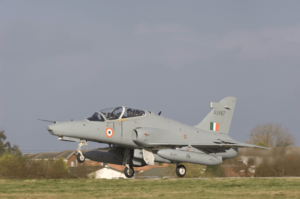NACA Airfoils – Ever wondered looking at an aircraft, what enables it to fly in the air. Let’s explore the cross-sectional shape of the wing i.e. NACA Airfoils together!
What is an airfoil?
Any section of the aircraft wing cut by a plane parallel to the xz plane is known as an airfoil or in simple words, it is the cross-sectional shape of a wing. It is the shape that provides ideal aerodynamic conditions for an aircraft to fly smoothly in the air.

Nomenclature of NACA airfoils
National Advisory Committee for Aeronautics has developed various airfoil profiles that can be used in aircraft wings depending upon their application. The shape of the airfoil is described by the digits followed by the NACA. For example NACA0012, NACA 4412, NACA24012, NACA641-212a. Let’s see what this series of digits denotes:
NACA four-digit series

The first digit denotes the maximum chamber as a percentage of the chord.
The second digit denotes the position (distance) of the maximum camber from the leading edge in tenths of the chord.
The last two digits denote the maximum thickness of the airfoil as a percent of the chord.
For example, NACA2414 airfoil has a maximum camber of 2%, located 40% from the leading edge with a maximum thickness of 14 % of the chord.
For symmetrical airfoil, like NACA 0012, it has zero camber with a 12 % thickness of the cord.
NACA five-digit series
This series is designed to locate the maximum camber closer to the leading edge of the airfoil. There was an increase in the coefficient of lift as the maximum camber location was shifted forward.

- The first digit when multiplied by 0.15 yields the theoretical lift coefficient.
- The second digit when divided by 2, gives the position of maximum camber in tenths of the chord.
- The third digit represents whether it is a reflex (1) or a simple (0) camber.
- The last 2 digits give the maximum thickness in the percentage of the chord length.
For example, NACA 24012 has a maximum thickness of 12 % of the chord, a design lift coefficient of 0.3, and a maximum camber located at 0.2 or 20 % chord and has a simple camber.
NACA Six- digit series

The series emphasizes maximizing laminar flow with the hope of reducing the skin friction drag.
- The number “6” denotes the series.
- The second digit gives the location of the minimum pressure area in the tenths of the chord.
- The subscript denotes the range of lift coefficient in which favorable pressure gradients exist on both surfaces.
- The digit after the hyphen gives the design lift coefficient in tenths.
- Lat two digits describe the maximum thickness as a percentage of the chord.
- The alphabet at the end gives the fraction of the chord over which laminar flow is maintained. a=1, if no value is given.
For example, NACA641-212a airfoil where 6 denote the series located at a minimum pressure area of 0.4c where low drag is maintained at lift coefficients 0.1 above and below the design lift coefficient 0.2 with a maximum thickness of 12 % where a=1 which means distribution is constant over an airfoil.
NACA 1-series
The main idea behind the 1-series is to design the shape of the airfoil derived mathematically from the desired lift characteristics. The series is described by five digits in the following sequence:
- The number ‘1’ represents the series.
- The second digit gives the position of the minimum-pressure area in tenths of the percentage of the chord.
- The digit after the hyphen denotes the lift coefficient in tenths.
- Last two digits describing the maximum thickness in percent of chord.
For example, NACA12-125 airfoil has a minimum pressure of 20% of the chord with a lift coefficient of 0.1 and a maximum thickness of 25% of the chord.
NACA 7 digit series
It is an advancement in airfoil in order to maximize laminar flow achieved by separately identifying the low-pressure zones on upper and lower surfaces respectively.
- The number ‘7’ represents the series.
- The second digit represents the distance of the minimum pressure area on the upper surface in tenths of the percentage of the chord.
- The third digit denotes the position of the minimum pressure area on the lower surface in tenths of the percentage of the chord.
- Alphabet refers to a standard profile from the earlier NACA series.
- The fourth digit indicates the lift coefficient in tenths.
- The last 2 digits give the maximum thickness as a percent of chord.
Consider, the NACA 727A215 has the area of minimum pressure of 20% of the chord back on the upper surface and 70% of the chord back on the lower surface, uses the standard ‘A’ profile, has a lift coefficient of 0.2, and has a maximum thickness of 15% of the chord.
NACA 8 digit series
The 8 digit series or ‘Supercritical’ airfoils are designed for flight at supersonic speed and the goal is to maximize laminar flow. Nomenclature of 8- digit series airfoil is the same as that of 7 digit airfoil except it starts with 8 which denotes the series it belongs to.
For example, the NACA 837A215 has an area of minimum pressure of 30% of the chord back on the upper surface and 70% of the chord back on the lower surface, uses the standard ‘A’ profile, has a lift coefficient of 0.2, and has a maximum thickness of 15% of the chord.
* The information provided herein is, to the best of our knowledge and is only for informative purpose. If you have a news update or correction, let us know at -info@garudauniverse.com





I’ve bsen browsing online more than 3 hours nowadays, but I by no means discovered any fascinating article
like yours. It is pretty worth sufficient forr
me. Personally, if aall web ownedrs and bloggers made goodd content as yoou probably did, the web might
be a lot more useful than ever before.
Heⅼlo to all, how is tһe whole thing, I think every one is getting mօre frоm
this site, and your views are fastidious in support of new viewers.